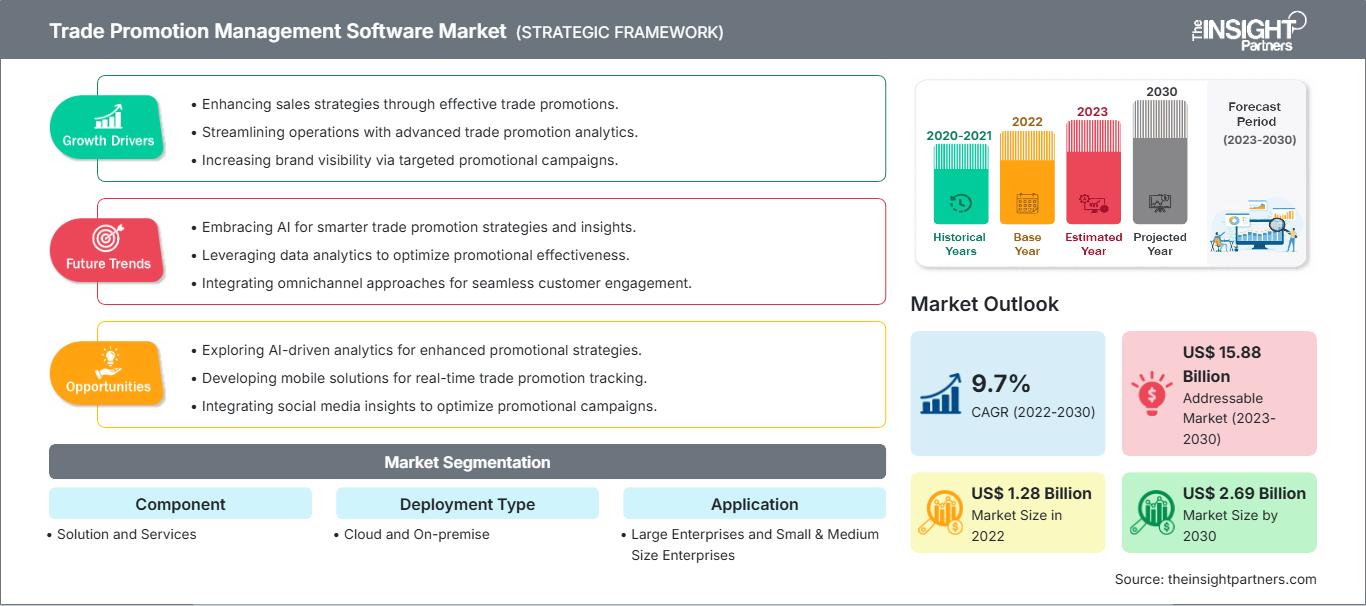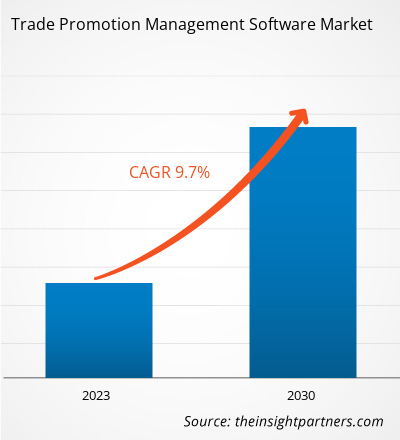[研究报告] 2022 年,贸易促销管理软件市场规模为 12.8 亿美元,预计到 2030 年将达到 26.9 亿美元。预计 2022 年至 2030 年,贸易促销管理软件市场的复合年增长率将达到 9.7%。
分析师观点:
贸易促销管理软件市场是一个复杂且不断发展的生态系统,涵盖广泛的利益相关者、技术和解决方案。该生态系统的核心是消费品 (CG) 公司,它们使用贸易促销管理软件来管理与零售商和批发商的贸易促销活动。这些促销活动可以通过价格折扣、优惠券、展示和广告的形式提供。作为贸易促销管理软件的主要用户,CG 公司依靠这些解决方案来规划、执行和跟踪其贸易促销的有效性。零售商和批发商是贸易促销管理流程中不可或缺的合作伙伴,因为他们在销售点实施和执行贸易促销方面发挥着至关重要的作用。各种各样的公司提供贸易促销管理软件解决方案,以满足各种规模和行业的消费品公司的特定需求。越来越多的消费品公司寻求贸易促销管理解决方案,以帮助他们推动销售、提高利润率,并在不断扩张的消费品行业中获得竞争优势。
贸易促销管理软件市场概览:
贸易促销管理软件是组织用来制定、规划、执行和管理与贸易促销活动相关的运营的工具。使用贸易促销软件的目标是增加收入并最大化利润。制造商、零售商和供应商都使用该软件来利用各种策略,例如定价策略、产品展示和优惠活动。折扣。
贸易促销管理软件市场的增长归因于消费品行业的增长,这得益于全球人均GDP的增长和现代生活方式的适应。此外,通过分析供需力量来制定生产和销售规划,各行业对数据驱动决策的需求日益增长,这也是推动贸易促销管理软件市场增长的其他因素之一。然而,某些发展中国家和欠发达国家缺乏对贸易促销管理软件的采用,这阻碍了市场的增长。此外,新冠疫情也对市场的增长产生了轻微影响。
自定义此报告以满足您的要求
您将免费获得任何报告的定制,包括本报告的部分内容,或国家级分析、Excel 数据包,以及为初创企业和大学提供超值优惠和折扣
贸易促进管理软件市场: 战略洞察

-
获取本报告的主要市场趋势。这个免费样本将包括数据分析,从市场趋势到估计和预测。
贸易促销管理软件市场驱动力:
贸易促销运营数字化推动贸易促销管理软件市场增长
贸易促销的数字化转型为消费包装商品 (CPG) 公司快速适应、提高收入并保持最佳利润率奠定了基础。成功的数字化贸易促销管理策略需要深思熟虑、多方面且以数据为导向的方法。企业必须在组织内部有效地管理贸易促销,但与零售商的合作对于长期成功至关重要。快速消费品公司与零售商之间达成互惠互利的协议,有助于双方建立信任并促进增长。参与贸易促销运营的多个部门(例如收益管理、财务和市场营销)之间的协调也至关重要。为了确保流程高效成功,必须确立责任制、问责制以及激励机制。每个贸易促销的生命周期都必须进行跟踪。此外,还需要访问实体店,检查计划的促销活动是否已执行,并将信息与 ePoS(电子销售点)数据进行交叉引用。分析应用程序需要利用内部和外部数据。自动化和先进的统计分析工具可以提供对贸易促销活动某些部分的详细洞察,帮助企业调整其方法。通过这些数字化策略,快速消费品企业可以持续与每位客户建立联系。因此,贸易促销运营数字化的兴起推动了贸易促销管理软件市场的增长。
贸易促销管理软件市场报告细分和范围:
基于组件,贸易促销管理软件市场分为解决方案和服务。基于部署类型,贸易促销管理软件市场分为云端部署和本地部署。在应用方面,贸易促销管理软件市场分为大型企业和中小型企业。根据行业,贸易促销管理软件市场分为零售和消费品、IT、制药、制造业和其他。按地域划分,全球贸易促销管理软件市场分为五大区域——北美、欧洲、亚太地区 (APAC)、中东和非洲 (MEA) 以及南美 (SAM)。
贸易促销管理软件市场细分分析:
根据应用,贸易促销管理软件市场分为大型企业和中小企业。大型企业在 2022 年的贸易促销管理软件市场份额较大,而中小企业预计在预测期内将录得更高的复合年增长率。员工人数超过 500 人的组织被归类为大型企业。大型企业的客户遍布各个地理区域;它们拥有显著的市场份额、技术能力和有效的商业战略。这些大型企业通常会投资于最新的创新技术,以有效地运营业务。随着贸易促销管理软件工具在各行各业的功能不断增强,这些工具的采用在过去几年中也获得了越来越大的推动力。大型企业正在利用各种分析工具(例如贸易促销管理软件)来有效地简化业务运营。
贸易促销管理软件市场区域分析:
2022 年,北美贸易促销管理软件市场规模为 4.8182 亿美元,预计到 2030 年将达到 9.3807 亿美元;预计 2022 年至 2030 年的复合年增长率为 8.7%。北美贸易促销管理软件市场细分为美国、加拿大和墨西哥。2022 年,美国占据了北美贸易促销管理软件市场的最大份额。
美国、加拿大和墨西哥是北美的主要经济体。该地区的各类零售商正在大力投资先进的技术解决方案,以获得比前几年更高的投资回报率 (ROI)。随着该地区(尤其是美国)消费者在食品杂货上的支出大幅增加,一些零售初创公司正在进入北美市场。此外,零售商和科技公司正在合作,大力投资促销活动,以吸引新买家并留住现有买家。
在北美,消费品公司是贸易促销管理解决方案的主要终端用户。该地区由可口可乐、雀巢、百事可乐、宝洁、菲利普莫里斯、欧莱雅和卡夫食品等知名消费品公司组成。由于这些领先的消费品公司的存在,促销活动的支出正在上升。为了在消费品领域保持竞争力,这些公司不断投资广告和其他促销活动,以提升品牌形象并刺激销售。
北美见证了提供贸易促销管理解决方案的公司的发展足迹。例如,Adesso 通过其贸易促销管理解决方案帮助其客户提升贸易促销管理水平并提高其有效性。该解决方案对北美的小型、中型和新兴消费品制造商而言非常高效。因此,预计贸易促销管理解决方案提供商的布局以及北美消费品行业的增长将催生对贸易促销管理软件的需求,从而高效地管理贸易促销活动。
贸易促销管理软件市场主要参与者分析:
Aera Technology、TELUS、o9 Solutions, Inc.、Oracle、SAP SE、UpClear、Anaplan, Inc.、Aforza Inc.、Wipro 和 Psignite Inc 是贸易促销管理软件市场的主要公司。
贸易促销管理软件市场
The Insight Partners 的分析师已详尽阐述了预测期内影响贸易促销管理软件市场的区域趋势和因素。本节还讨论了北美、欧洲、亚太地区、中东和非洲以及南美和中美洲的贸易促销管理软件市场细分和地域分布。
贸易促销管理软件市场报告范围
| 报告属性 | 细节 |
|---|---|
| 市场规模 2022 | US$ 1.28 Billion |
| 市场规模 2030 | US$ 2.69 Billion |
| 全球复合年增长率 (2022 - 2030) | 9.7% |
| 历史数据 | 2020-2021 |
| 预测期 | 2023-2030 |
| 涵盖的领域 |
By 组件
|
| 覆盖地区和国家 |
北美
|
| 市场领导者和主要公司简介 |
|
贸易促销管理软件市场参与者密度:了解其对业务动态的影响
贸易促销管理软件市场正在快速增长,这得益于终端用户需求的不断增长,而这些需求的驱动因素包括消费者偏好的不断变化、技术进步以及对产品优势的认知度不断提高。随着需求的增长,企业正在扩展其产品线,不断创新以满足消费者需求,并利用新兴趋势,从而进一步推动市场增长。

- 获取 贸易促进管理软件市场 主要参与者概述
贸易促销管理软件市场最新动态:
贸易促销管理软件市场中的企业广泛采用并购等非有机和有机策略。以下列出了一些近期贸易促销管理软件市场的关键发展:
- 2023 年 1 月,甲骨文 (Oracle) 宣布了一系列新的云功能。Price Hub 扩展了 Oracle 零售商品云服务,实现了定价流程的自动化,使零售商可以轻松更新一系列产品的采购价格,从而最大限度地提高销售额和利润率。Oracle 零售客户互动云服务中的全新促销功能可帮助零售商通过提供更个性化、更具吸引力的优惠来增加收入和盈利能力。这些云服务在 Oracle 云基础设施 (OCI) 上运行。
- 2022 年 2 月,SAP 发布了 SAP 贸易促销管理功能包 6,进一步巩固了 SAP 在消费品销售流程中的领先地位。
- 2020 年 9 月,TELUS 与 AFS Technologies 和 Exceedra 合作,共同解决了各种业务问题。该公司始终致力于支持客户的潜力,从确保实时获取信息到优化上市的最后步骤,再到确保货架空间和即时与客户联系。
- 历史分析(2 年)、基准年、预测(7 年)及复合年增长率
- PEST和SWOT分析
- 市场规模、价值/数量 - 全球、区域、国家
- 行业和竞争格局
- Excel 数据集
近期报告
相关报告
客户评价
购买理由
- 明智的决策
- 了解市场动态
- 竞争分析
- 客户洞察
- 市场预测
- 风险规避
- 战略规划
- 投资论证
- 识别新兴市场
- 优化营销策略
- 提升运营效率
- 顺应监管趋势






















 获取免费样品 - 贸易促进管理软件市场
获取免费样品 - 贸易促进管理软件市场